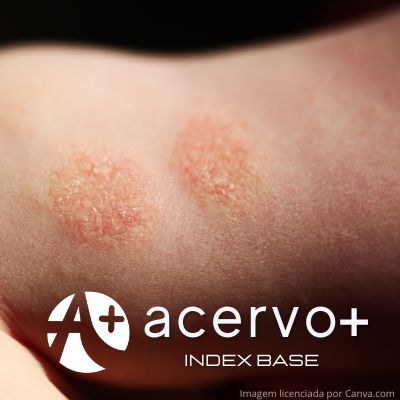Uma análise sobre as características da dermatite atópica: revisão de literatura
##plugins.themes.bootstrap3.article.main##
Resumo
Objetivo: Analisar as características da Dermatite Atópica (DA). Revisão bibliográfica: A DA é a condição inflamatória crônica da pele mais prevalente em todo o mundo de caráter recidivante que passa repetidamente pelos seguintes estágios: exacerbação e melhora. Uma história familiar de doença atópica, incluindo asma e rinite alérgica, predispõe ao desenvolvimento de DA. Sua fisiopatologia compreende a disfunção da barreira cutânea e a desregulação imunológica. O principal sintoma da DA é o prurido, estando este associado a sofrimento mental e desenvolvimento de depressão e ansiedade. Considerações finais: A DA é uma doença associada a fatores genéticos e ambientais, caracterizada principalmente pelo prurido e eczema que causa diminuição na qualidade de vida dos pacientes. Sua terapêutica inclui além da prevenção dos fatores ambientais, a hidratação da pele, o uso de corticóides tópicos e medicações sistêmicas em casos mais graves. Nesse sentido, torna-se essencial um correto diagnóstico e tratamento multidisciplinar desses pacientes visando não somente o controle da doença e a prevenção das infecções como o cuidado psicológico de modo a evitar o desenvolvimento de transtornos depressivos e ansiosos.
##plugins.themes.bootstrap3.article.details##
Copyright © | Todos os direitos reservados.
A revista detém os direitos autorais exclusivos de publicação deste artigo nos termos da lei 9610/98.
Reprodução parcial
É livre o uso de partes do texto, figuras e questionário do artigo, sendo obrigatória a citação dos autores e revista.
Reprodução total
É expressamente proibida, devendo ser autorizada pela revista.
Referências
2. ABUABARA K, et al. The Long-Term Course of Atopic Dermatitis. Dermatol Clin, 2017; 35(3): 291- 297.
3. ALI F, et al. Counting the Burden: Atopic Dermatitis and Health-related Quality of Life. Acta Derm Venereol, 2020; 100(12):adv00161.
4. AVENA-WOODS C. Overview of atopic dermatitis. Am J Manag Care, 2017; 23(8): S115-S123.
5. BROWN SJ, et al. Genetics in Atopic Dermatitis: Historical Perspective and Future Prospects. Acta Derm Venereol, 2020; 100(12): adv00163.
6. BYLUND S, et al. Prevalence and Incidence of Atopic Dermatitis: A Systematic Review. Acta Derm Venereol, 2020; 100(12): adv00160.
7. BRUNNER PM, et al. Immunologic, microbial, and epithelial interactions in atopic dermatitis. Ann Allergy Asthma Immunol, 2018; 120(1): 34-41.
8. EDSLEV SM, et al. Skin Microbiome in Atopic Dermatitis. Acta Derm Venereol, 2020; 100(12): adv00164.
9. EZZEDINE K, et al. Impact of Atopic Dermatitis in Adolescents and their Parents: A French Study. Acta Derm Venereol, 2020; 100(17): adv00294.
10. FISHBEIN AB, et al. Update on Atopic Dermatitis: Diagnosis, Severity Assessment, and Treatment Selection. J Allergy Clin Immunol Pract, 2020; 8(1): 91-101.
11. FLEMING P, et al. Diagnosis and Management of Atopic Dermatitis for Primary Care Providers. J Am Board Fam Med, 2020; 33(4):626-635. .
12. FRAZIER W, BHARDWAJ N. Atopic Dermatitis: Diagnosis and Treatment. Am Fam Physician, 2020; 101(10): 590-598.
13. FUJI M. Current Understanding of Pathophysiological Mechanisms of Atopic Dermatitis: Interactions among Skin Barrier Dysfunction, Immune Abnormalities and Pruritus. Biol Pharm Bull, 2020; 43(1):12-19.
14. GERNER T, et al. Atopic dermatitis. Ugeskr Laeger, 2018; 180(4): V04170331.
15. JOHANSSON EK. Psychiatric conditions in children with atopic dermatitis. Br J Dermatol, 2021; 185(1):8-9.
16. KAUPPI S, et al. Adult Patients with Atopic Eczema have a High Burden of Psychiatric Disease: A Finnish Nationwide Registry Study. Acta Derm Venereol, 2019; 99(7): 647-651.
17. KIM J, et al. Pathophysiology of atopic dermatitis: Clinical implications. Allergy Asthma Proc, 2019; 40(2):84-92.
18. KULTHANAN K, et al. Clinical practice guidelines for the diagnosis and management of atopic dermatitis. Asian Pac J Allergy Immunol, 2021; 39(3):145-155.
19. LIN TK, et al. Association between Stress and the HPA Axis in the Atopic Dermatitis. Int J Mol Sci, 2017; 18(10): 2131.
20. NA CH, et al. A Therapeutic Renaissance - Emerging Treatments for Atopic Dermatitis. Acta Derm Venereol, 2020; 100(12):adv00165.
21. NARLA S, SILVERBERG JI. Dermatology for the internist: optimal diagnosis and management of atopic dermatitis. Ann Med, 2021; 53(1):2165-2177.
22. NAKATSUJI T, GALLO RL. The role of the skin microbiome in atopic dermatitis. Ann Allergy Asthma Immunol, 2019; 122(3):263-269.
23. ROBINSON RG, SINGH AM. Controversies in Allergy: Food Testing and Dietary Avoidance in Atopic Dermatitis. J Allergy Clin Immunol Pract, 2019; 7(1):35-39.
24. SOUTO EB, et al. Trends in Atopic Dermatitis-From Standard Pharmacotherapy to Novel Drug Delivery Systems. Int J Mol Sci, 2019; 20(22):5659.
25. TAMAGAWA-MINEKOA R, KATOH N. Atopic Dermatitis: Identification and Management of Complicating Factors. Int J Mol Sci, 2020; 21(8):2671.
26. TRAIDL S, WERFEL T. Allergen immuntherapie bei atopischer Dermatitis [Allergen immunotherapy for atopic dermatitis]. Hautarzt, 2021; 72(12):1103-1112.
27. YANG G, et al. Skin Barrier Abnormalities and Immune Dysfunction in Atopic Dermatitis. Int J Mol Sci, 2020; 21(8): 2867.
28. WANG V, et al. The infectious complications of atopic dermatitis. Ann Allergy Asthma Immunol, 2021; 126(1): 3-12.

